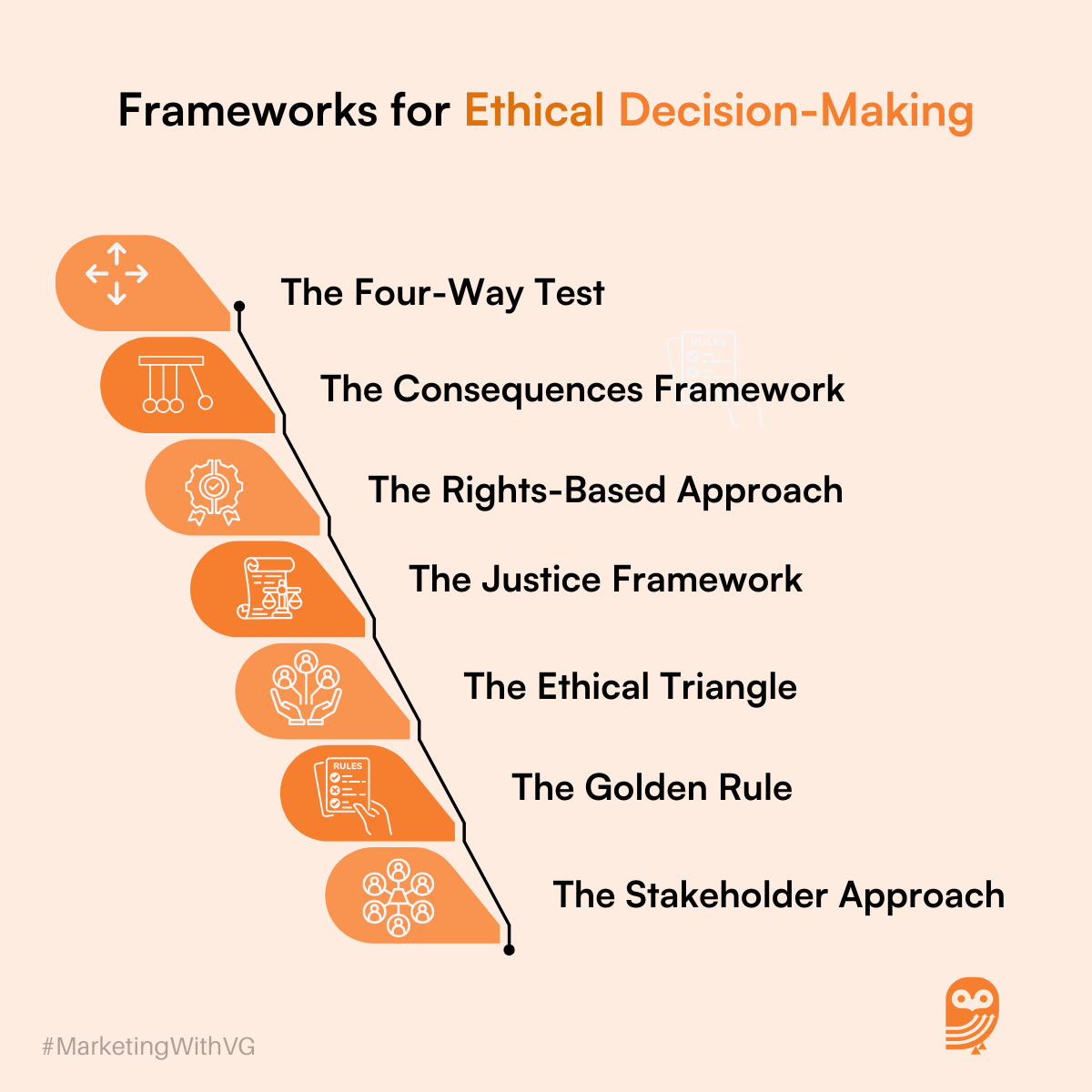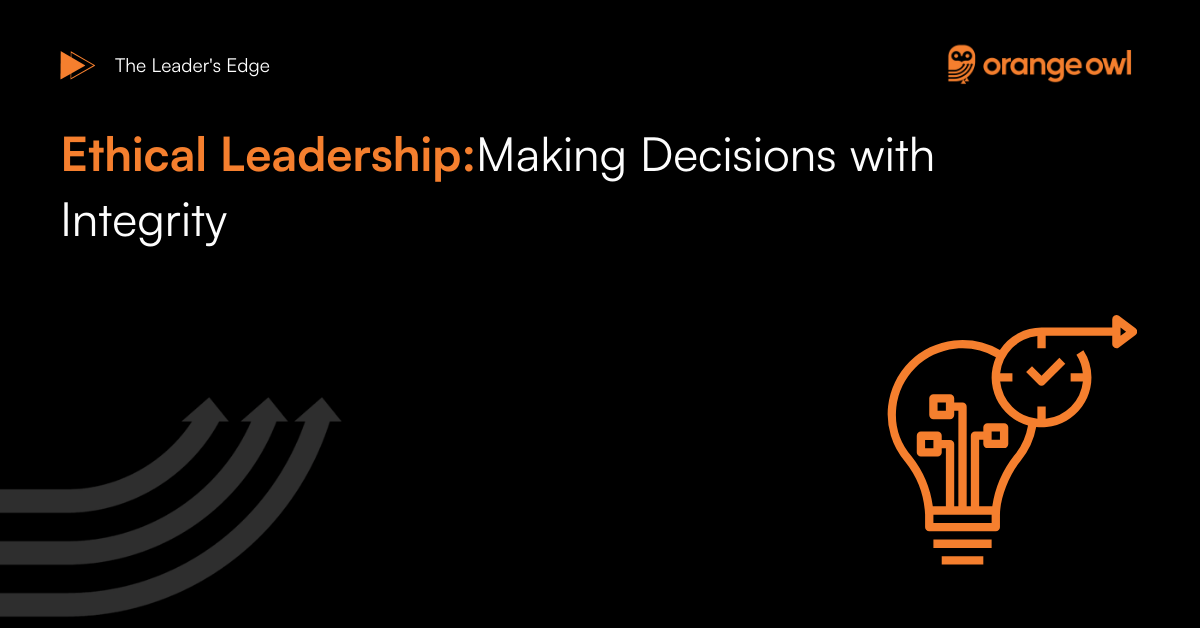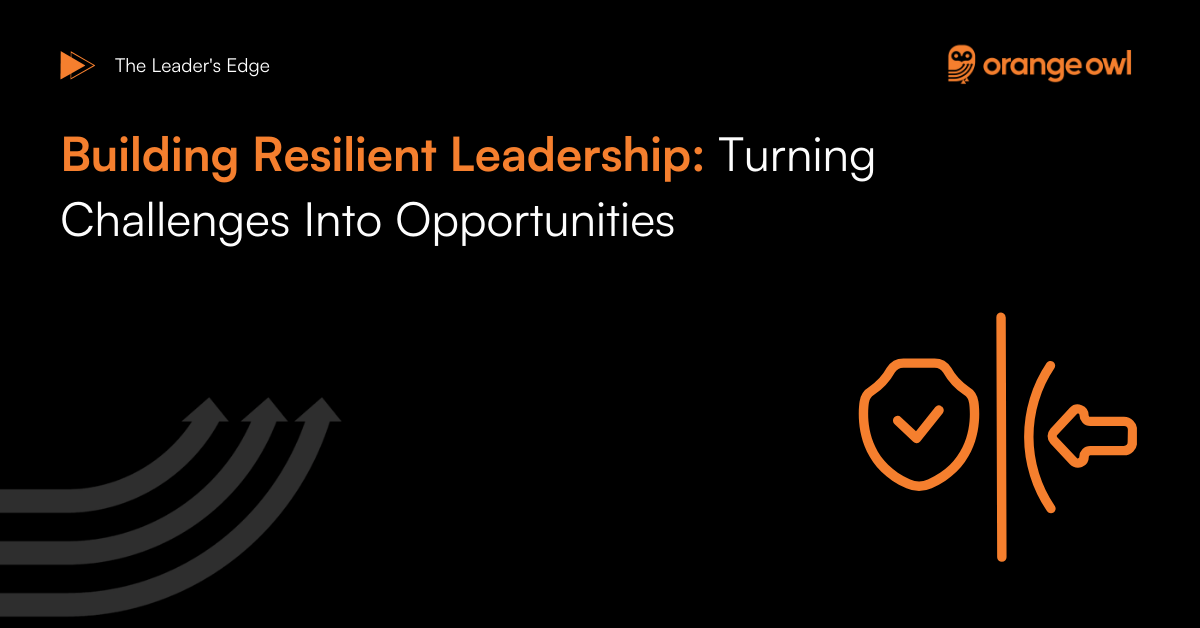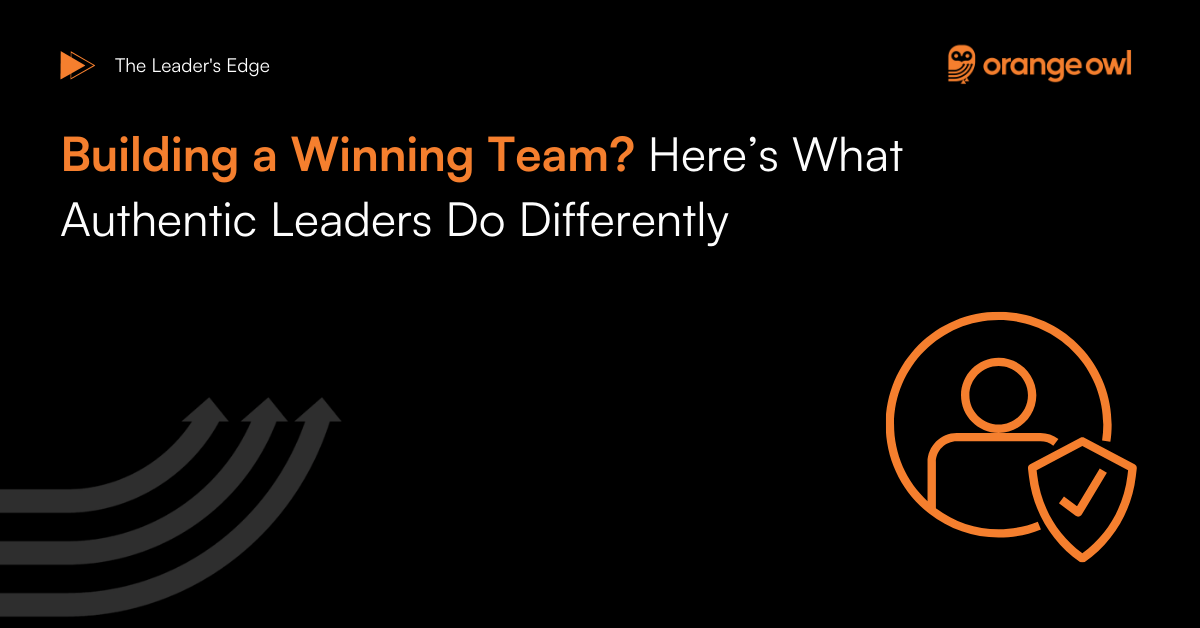This article delves into common ethical dilemmas, frameworks for making sound ethical decisions, and practical scenarios that highlight how leaders can navigate these challenges with integrity.
But first, let’s understand what ethical leadership truly means through examples from different industries.
What is Ethical Leadership?
Ethical leadership is the practice of guiding an organization with principles that prioritize fairness, transparency, accountability, and respect for all stakeholders. It’s not just about adhering to regulations but about embodying values that build trust and foster long-term relationships. Ethical leaders lead by example, setting a standard of behavior that inspires others to act with integrity.
Technology Industry: In a data privacy scenario, an ethical leader at a B2B SaaS company might choose to notify clients promptly about a potential data breach, despite the risk of reputational damage. By prioritizing transparency and client trust over short-term business interests, they demonstrate ethical leadership.
Healthcare Industry: A leader in a pharmaceutical company might halt a product launch after discovering incomplete safety trials, even if it delays profits. This decision reflects a commitment to patient safety and regulatory integrity, embodying the essence of ethical leadership.
Retail Industry: In retail, ethical leadership might involve ensuring suppliers adhere to fair labor practices, even if it increases production costs. By valuing human rights and ethical sourcing over profit margins, leaders set a precedent for responsible business operations.
Ethical leadership ensures that decisions align with the organization’s core values, balancing profitability with accountability and care for stakeholders.
The Importance of Ethical Leadership in Modern Organizations
Building Trust: Ethical leaders inspire confidence in their teams, customers, and stakeholders by consistently acting in alignment with their values.
Fostering a Positive Culture: A leader’s ethical choices shape the organization’s culture, encouraging employees to act with integrity.
Mitigating Risks: Ethical leadership reduces the risk of legal and reputational damage by prioritizing transparency and fairness.
Driving Long-Term Success: Organizations led by ethical leaders tend to be more sustainable, as they focus on equitable and responsible practices.
Common Ethical Dilemmas Leaders Face
Conflict of Interest: Balancing personal gains with professional responsibilities.
Resource Allocation: Deciding how to distribute limited resources fairly among stakeholders.
Truth vs. Loyalty: Choosing between honesty and loyalty to a colleague, friend, or team.
Short-Term Gains vs. Long-Term Values: Making decisions that align with the organization’s principles despite immediate pressures.
Diversity and Inclusion: Addressing unconscious bias in hiring, promotions, or team dynamics.
Frameworks for Ethical Decision-Making
1. The Four-Way Test
The Four-Way Test evaluates decisions based on four critical questions:
1. Is it the truth?
2. Is it fair to all concerned?
3. Will it build goodwill and better relationships?
4. Will it be beneficial to all concerned?
Example: Balancing Transparency and Morale
Scenario: A company faces a downturn, and layoffs are imminent. Employees are unaware of the financial challenges.
Resolution Using the Four-Way Test:
Is it the truth? The leader communicates the financial situation truthfully to the employees.
Is it fair to all concerned? The leader evaluates ways to minimize layoffs, such as voluntary pay cuts or furloughs, ensuring fairness across the organization.
Will it build goodwill and better relationships? Transparent communication fosters trust between leadership and employees, even in tough times.
Will it be beneficial to all concerned? While layoffs might still occur, the process ensures fairness and minimizes negative impact.
Outcome: By using this test, the leader communicates with integrity and explores equitable solutions, maintaining trust within the organization.
2. The Consequences Framework
This framework focuses on evaluating the potential outcomes of a decision:
1. Who will benefit, and who might be harmed?
2. What are the short-term and long-term impacts?
Example: Allocating Limited Resources
Scenario: A department receives budget cuts and must choose between funding a new product launch or providing necessary equipment for an underperforming team.
Resolution Using the Consequences Framework:
Who will benefit and who might be harmed? Funding the product launch could benefit the company’s reputation and revenue, but the underperforming team might feel neglected, leading to further morale and productivity issues.
Short-term impact: The product launch brings quick wins, but the neglected team may face burnout.
Long-term impact: The neglected team’s productivity issues could eventually harm company operations, outweighing the benefits of the product launch.
Outcome: The leader decides to invest in the team’s equipment first, ensuring long-term operational stability while delaying the product launch to a time when resources are more readily available.

3. The Rights-Based Approach
This approach ensures decisions respect the rights and dignity of all individuals involved.
Example: Ethical Hiring Practices
Scenario: During a hiring process, a candidate from an underrepresented group is clearly qualified but faces subtle bias from the panel due to stereotypes.
Resolution Using the Rights-Based Approach:
The leader reminds the panel of the candidate’s right to a fair and unbiased evaluation.
They implement structured, criteria-based assessments to ensure the hiring process is objective.
The leader provides training to the panel on unconscious bias, reinforcing the importance of respecting candidates’ rights.
Outcome: The most qualified candidate is selected, and the organization demonstrates its commitment to fairness and inclusion.
4. The Justice Framework
The Justice Framework prioritizes fairness and equity, ensuring no group is unfairly advantaged or disadvantaged.
Example: Promoting Equity in Team Rewards
Scenario: A manager must distribute bonuses to a team where some members worked overtime while others contributed equally but within regular hours.
Resolution Using the Justice Framework:
The manager considers factors like effort, results, and the availability of overtime opportunities.
They ensure overtime work is rewarded while also recognizing significant contributions from those who stayed within their regular hours.
Bonuses are distributed in a tiered system, balancing effort and equity.
Outcome: The decision acknowledges diverse contributions, maintaining fairness and morale across the team.
5. The Ethical Triangle
The Ethical Triangle combines three perspectives:
1. Virtue Ethics: What would a good or moral person do?
2. Consequentialism: What decision will produce the best outcomes?
3. Deontology: What rules, policies, or principles must be followed?
Example: Managing Vendor Relationships
Scenario: A vendor offers a gift to a procurement officer, violating the company’s no-gift policy.
Resolution Using the Ethical Triangle:
Virtue Ethics: A good person would refuse the gift, understanding the importance of impartiality in vendor relationships.
Consequentialism: Accepting the gift could lead to biased decisions and harm the company’s reputation, outweighing any personal benefit.
Deontology: The company’s no-gift policy is clear, and adhering to it ensures transparency and fairness.
Outcome: The officer politely declines the gift and reports the offer to the leadership, reinforcing the company’s commitment to ethical practices.
6. The Golden Rule
The Golden Rule advises leaders to treat others as they would want to be treated.
Example: Handling Employee Misconduct
Scenario: A high-performing employee violates company policy.
Resolution Using the Golden Rule:
The leader considers how they would want to be treated in a similar situation: with fairness and an opportunity to explain.
They conduct a private, unbiased conversation with the employee, seeking to understand their perspective.
After evaluating the situation, they issue a proportionate consequence while providing guidance to prevent future violations.
Outcome: The employee feels heard and respected, even if consequences are applied, and the rest of the team sees that policies are enforced fairly.
7. The Stakeholder Approach
This approach evaluates decisions based on their impact on all stakeholders, including employees, customers, investors, and the community.
Example: Product Recall Decision
Scenario: A company discovers a defect in a product that poses a minor safety risk but recalling it would be costly and harm investor relations.
Resolution Using the Stakeholder Approach:
The leader evaluates the impact on customers (safety concerns), employees (possible layoffs due to costs), and investors (financial losses).
They prioritize customer safety, initiate a recall, and communicate openly with stakeholders about the corrective measures.
Outcome: While the recall incurs short-term losses, the company maintains customer trust and demonstrates its commitment to safety, reinforcing its brand integrity.
Practical Scenarios and How to Handle Them
Scenario 1: A Conflict of Interest
A senior manager is part of a hiring panel for a new leadership role. One of the candidates is a close friend.
Ethical Dilemma: Should the manager recuse themselves or continue on the panel?
Resolution: The manager acknowledges the conflict and steps aside, ensuring the hiring process remains impartial. Transparency is maintained by informing the panel and HR about the decision.
Scenario 2: Resource Allocation
A leader oversees a budget cut and must decide whether to reduce team headcount or halt employee benefits.
Ethical Dilemma: Balancing financial constraints with employee welfare.
Resolution: The leader organizes a meeting with team representatives to discuss potential solutions. They decide to temporarily reduce non-essential benefits while ensuring job security, demonstrating empathy and fairness.
Scenario 3: Truth vs. Loyalty
An employee, who is a close friend, has been falsifying expense reports.
Ethical Dilemma: Should the leader report the misconduct or stay loyal to the friend?
Resolution: The leader follows company policy and reports the incident. To maintain respect, they personally inform the friend beforehand, emphasizing the importance of accountability and fairness to all employees.
Scenario 4: Short-Term Gains vs. Long-Term Values
A client offers a lucrative contract but requests that the company bypass certain legal regulations to expedite the project.
Ethical Dilemma: Should the leader accept the contract to meet quarterly revenue targets?
Resolution: The leader declines the contract, explaining the company’s commitment to ethical practices. They then work with the sales team to identify alternate clients or opportunities to fill the gap.
Scenario 5: Diversity and Inclusion
A hiring manager receives internal pressure to hire a candidate based on their relationship with a senior executive, bypassing more qualified candidates.
Ethical Dilemma: Should the manager prioritize merit or yield to internal politics?
Resolution: The manager adheres to fair hiring practices and selects the most qualified candidate. They diplomatically communicate their decision to the executive, emphasizing the importance of maintaining a merit-based culture.
How to Cultivate Ethical Leadership in Your Organization
Lead by Example:
Ethical behavior starts at the top. Demonstrate integrity in every decision to set the tone for your organization.
Create a Code of Ethics:
Develop clear guidelines that outline acceptable behaviors and decision-making processes.
Encourage Open Dialogue:
Foster a culture where employees feel safe discussing ethical concerns without fear of retaliation.
Provide Training:
Offer regular workshops on ethical decision-making to help employees and leaders navigate complex situations.
Establish Accountability Mechanisms:
Implement systems to review and address ethical breaches transparently and fairly.
Conclusion: Ethical Leadership as a Legacy
Ethical leadership is not about perfection—it’s about consistently striving to make decisions that reflect integrity, fairness, and respect for all stakeholders. By using frameworks to navigate dilemmas and cultivating an ethical culture, leaders can inspire trust, build resilient teams, and leave a legacy of responsible decision-making.
At Orange Owl, we believe in empowering leaders to align their decisions with their values and organizational goals. Explore how we can support your leadership journey on our values page.



